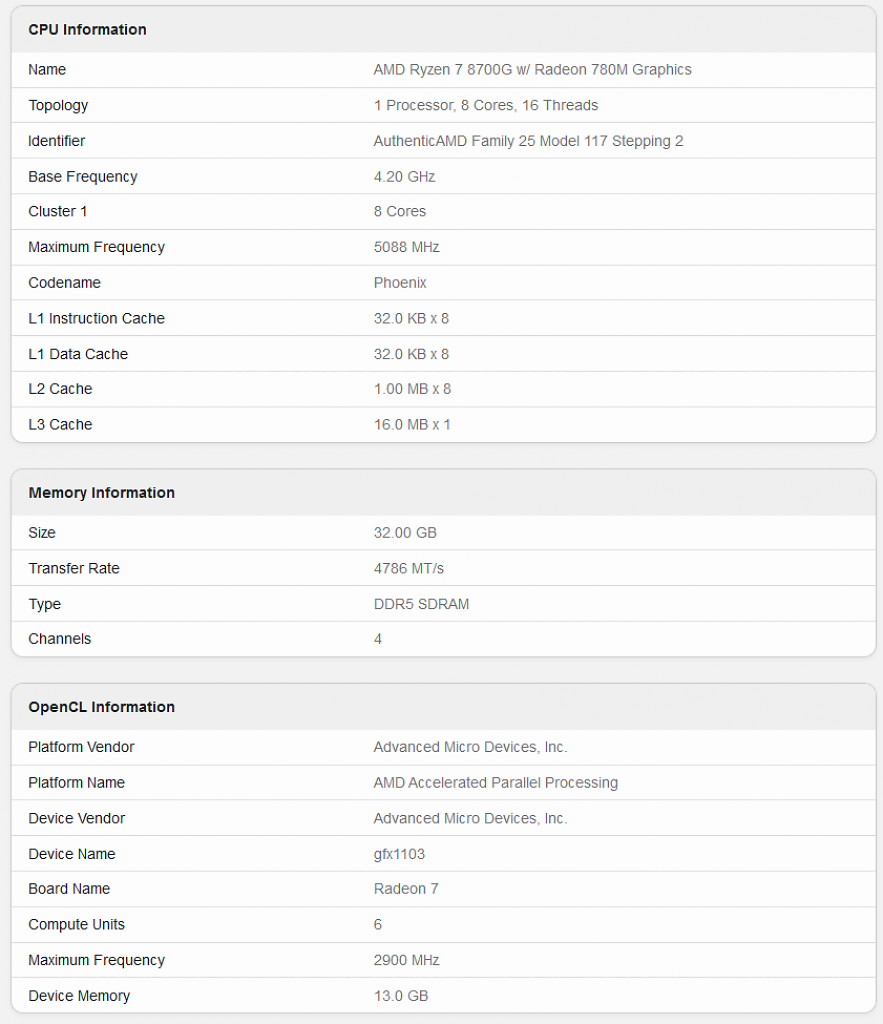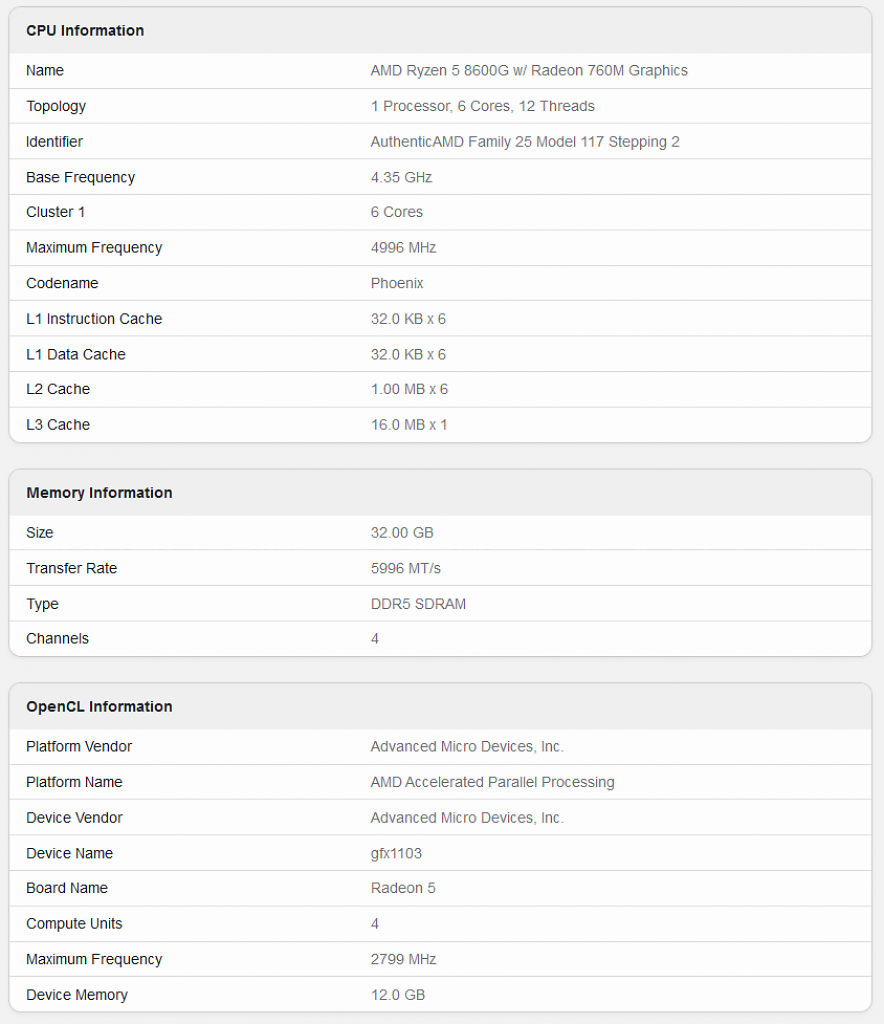The new AMD Ryzen 8000G (“Phoenix”) series desktop APUs are expected to be presented at CES 2024, which will take place in Las Vegas from January 9th to 12th. While a large part of the technical specifications have been leaked in the meantime, there was a question mark behind the clock frequencies of the integrated RDNA 3 graphics chip. The Radeon 780M with 12 compute units achieves very high clock frequencies of almost 3 GHz in the Ryzen 7 8700G.
Radeon 780M works at up to 2.9 GHz
The Radeon 780M based on the RDNA 3 architecture, which is used as the integrated graphics unit in the top model Ryzen 7 8700G, has 768 shader units, which, according to the first entries in the Geekbench benchmark database, have a high clock frequency of up to 2 .9 GHz work. The Radeon 760M with its 8 CUs and the resulting 512 execution units is used in the AMD Ryzen 5 8600G and therefore reaches up to 2.8 GHz. In direct comparison with the last generation of in-house desktop APUs, this is a huge leap.
AMD Ryzen 8000G (“Phoenix”)


The desktop APUs of the previous generation, such as the Ryzen 7 5700G (“Cezanne”), were still based on Zen 3 and an AMD Radeon Vega Graphics with GCN 5.1, which could be operated at a maximum of 2 GHz. In the desktop, the Radeon 780M is likely to be the fastest integrated graphics unit to date.
AMD Ryzen (Pro) 8000G (“Phoenix”)*
The technical specifications mentioned here have now been completely leaked and are confirmed as such by numerous sources.
| Codename | cores | threads | Basic clock | Boost clock | iGPU | Shaders | TDP | |
|---|---|---|---|---|---|---|---|---|
| Ryzen 7 8700G | Phoenix | 8 × Zen 4 | 16 | 4.20GHz | 5.10GHz | Radeon 780M | 768 | 65W |
| Ryzen 5 8600G | Phoenix | 6 × Zen 4 | 12 | 4.35GHz | 5.00GHz | Radeon 780M | 768 | 65W |
| Ryzen 5 8500G | Phoenix 2 | 2 × Zen 4 4 × Zen 4c | 12 | 3.55GHz | 5.00GHz | Radeon 760M | 512 | 65W |
| Ryzen 5 8500GE | Phoenix 2 | 2 × Zen 4 4 × Zen 4c | 12 | – | 5.00GHz | Radeon 760M | 512 | 35W |
| Ryzen 3 8300G | Phoenix 2 | 1 × Zen 4 3 × Zen 4c | 8th | 3.45GHz | 4.90GHz | Radeon 740M | 256 | 65W |
| Ryzen 3 8300GE | Phoenix 2 | 1 × Zen 4 3 × Zen 4c | 8th | – | 4.90GHz | Radeon 740M | 256 | 35W |
| Ryzen Pro 7 8700G | Phoenix | 8 × Zen 4 | 16 | 4.20GHz | 5.10GHz | Radeon 780M | 768 | 65W |
| Ryzen Pro 7 8700GE | Phoenix | 8 × Zen 4 | 16 | – | 5.10GHz | Radeon 780M | 768 | 35W |
| Ryzen Pro 5 8600G | Phoenix | 6 × Zen 4 | 12 | 4.35GHz | 5.00GHz | Radeon 760M | 512 | 65W |
| Ryzen Pro 5 8600GE | Phoenix | 6 × Zen 4 | 12 | – | 5.00GHz | Radeon 760M | 512 | 35W |
| Ryzen Pro 5 8500G | Phoenix 2 | 2 × Zen 4 4 × Zen 4c | 12 | 3.55GHz | 5.00GHz | Radeon 760M | 512 | 65W |
| Ryzen Pro 5 8500GE | Phoenix 2 | 2 × Zen 4 4 × Zen 4c | 12 | – | 5.00GHz | Radeon 760M | 512 | 35W |
| Ryzen Pro 3 8300G | Phoenix 2 | 1 × Zen 4 3 × Zen 4c | 8th | 3.45GHz | 4.90GHz | Radeon 740M | 256 | 65W |
| Ryzen Pro 3 8300GE | Phoenix 2 | 1 × Zen 4 3 × Zen 4c | 8th | – | 4.90GHz | Radeon 740M | 256 | 35W |
*) not officially confirmed.
While the regular models with the G suffix should have a cTDP of 45 to 65 watts, the models with the GE suffix come with a preset TDP of 35 watts and a correspondingly low base clock. The eight Pro models have the Pro feature set, which refers to software and support, but technically they are absolutely identical to the regular desktop APUs.
The presentation and market launch have already been confirmed
As Gigabyte has already officially confirmed, AMD’s new desktop APUs, which will most likely be marketed as Ryzen 8000G(E), will be available in stores at the end of January 2024. The new AGESA firmware version 1.1.0.0 already makes the AM5 mainboards compatible with the upcoming processors with Zen 4 and RDNA 3. This information comes from a current entry on Gigabyte’s support website and therefore corresponds to all previous ones Rumors that PCGH had previously reported in detail about.
The first prices, which cannot yet be viewed as RRP, and the official OPN numbers for the new desktop APUs have already been leaked.
Your opinion is asked!
What is your opinion on this topic? The PCGH editorial team would be pleased to hear your well-founded opinion in the comments to this report. To comment, you must be logged in to PCGH.de or the Extreme forum. If you don’t have an account yet, you can register here register without obligation. When commenting, please note the applicable regulations Forum rules.
Source: Geekbench

